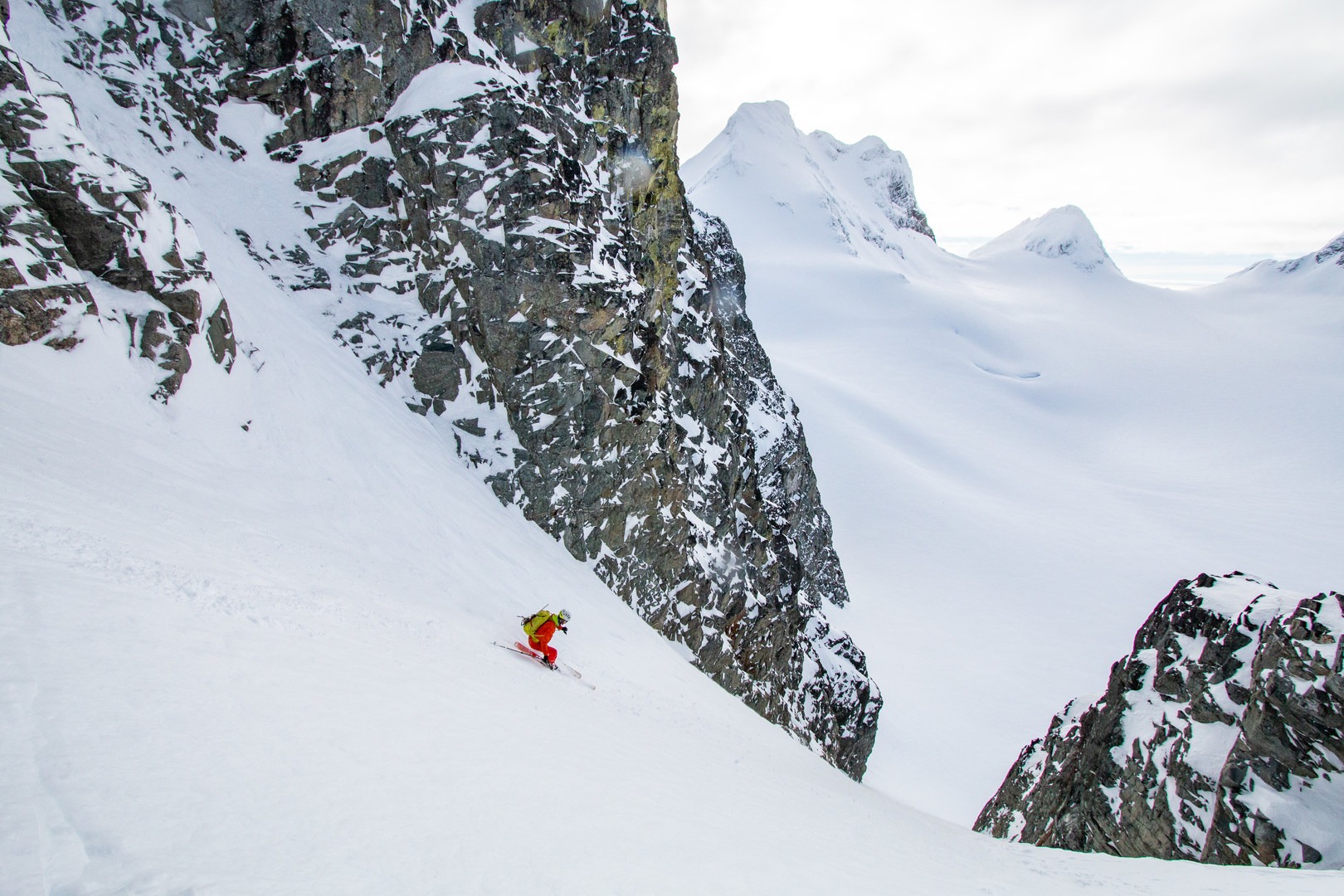You are here
The Aussie Couloir is a classic route in southwest British Columbia. The couloir runs for 450 metres and is 45 degrees from top to bottom, making for a huge line with a ton of superb skiing. Its proximity to Keith's Hut makes it a fairly straightforward two-day trip, but it can also be done in one big day. As of June 2019, this route is no longer safe to access. Until further notice, the Cerise Creek area is closed. Two large landslides have wiped out large sections of trail. There is also risk of further slides. This has dramatically altered the approach route along both summer and winter trails. It also poses a continued risk. BC Parks has closed the area. For updates visit the Nlhaxen Conservancy.
The route has a fairly long season, and the chute is usually well-filled most years by late December. Despite being south-facing, it tends to keep a fair amount of snow well into June and beyond. The main challenge will often be access to the hut. By April, the skin track can get choppy, making for awkward ski-outs.
To get the the couloir, take the left-hand winter trail to Keith's Hut. From here, take the northeast ridge of Joffre, also known as Motel 66 Ridge. There is usually a good track to follow all the way up to Motel 66, the large rump where the ridge drops slightly before joining the steep flank of Joffre. This vantage is excellent for gauging the overhead risk to come, though generally it's best to be doing this section in the dark. Turn headlamps off to get a sense of what's up there.
The next section is the riskiest in many conditions. There are two very steep slopes above. The farthest back is 35 degrees and frequently produces class 3 avalanches. It is best to stay lower to traverse across this steep section, staying just clear of the fans. Follow the normal precautions for overhead hazards here. Don't know what I mean by that? Turn around and enjoy the amazing turns off Joffre Shoulder instead.
From here it's a deceptively gentle skin up the glacier. You'll need to poke around the corner for your first glimpse of the Aussie Couloir. At the col, it's a brief drop down a gentle glacial arête that deposits you at the base. Head for the right-hand side, where a cozy alcove makes for an excellent and secure spot to transition to bootpacking.
The climbing is very straightforward. The snow varies, but I found it best for climbing on the right-hand side. If the sun is on the face above, expect to be pelted with ice. Keep an eye on this; it can increase in size and frequency, and it's not unusual for rock to fall as well. Avoid conditions when sun is on the upper face while you're descending.
Make a note of safe spots along the way. For photography, this is especially ideal. Rest here, and even dig out shelves for packs, which can save time on the descent. Just make sure you are well out of the center flow.
The descent is pretty wonderful with incredible views. Sustained and steep the whole way, its length adds to the challenge. Remember your safe spots and have fun.
Once out of the fan, it's a quick skin back up to the col. Descend the way you came. Some opt to head skiers right and ski the face of the glacier. This has become increasingly scoured with seracs in recent years and is not advisable. Better to stick to your tracks and ski along the bench between the rock bands, then drop through one of the chutes or the wider face down lower.
If you stay high exiting these features you can ski back to the hut without putting skins back on. Aim for the terminus of the morraine on skiers left. Ski out on the skin track. Be sure to watch out for folks coming up for the night.
Gear
What you take with you is depends on conditions.
- Helmets are essential due to the rock and ice fall.
- An ice axe can be nice. In soft conditions, the angle isn't too steep so reversed poles or a whippet is fine. But this can get really hard-packed with the sun, so it's perhaps better to be properly prepared.
- While it's easy to avoid the most risky crevasses, if you get caught in low visibility they can be impossible to see and still active even with 4 meters of snow on the glacier. A proper crevasse rescue kit is therefore always strongly recommended.
The Aussie Couloir on Joffre Peak is a big route that requires advanced mountaineering and skiing skills. Getting to the couloir involves crossing glacier terrain and some very serious avalanche hazard. The couloir is very steep, much longer, and more sustained than anything inbounds. If this is your first couloir, make sure you're going with steep skiing veterans. Skiers attempting this should be very experienced: double blacks should be near effortless, glacier mountaineering experience should be a given, and whiteout navigation and Avalanche Safety Training Level 2 should be a minimum before setting out on this objective.
Logistics + Planning
Current Weather: Powered by Dark Sky
























Comments
Until further notice the Cerise Creek area is closed. Two Large landslides have wiped out large sections of trail. There is also risk of further slides. See photos from Drew Bradshaw attached. This has dramatically altered the Approach route along both Summer and Winter Trails. It also poses a continued risk.
BC Parks has closed the area. For updates visit the Nlhaxen Cosnervancy Website: http://www.env.gov.bc.ca/bcparks/explore/cnsrvncy/nlhaxten-cerise-crk/
Lee Lau's Website has the best information cataloging the change and conditions.
Sign In and share them.